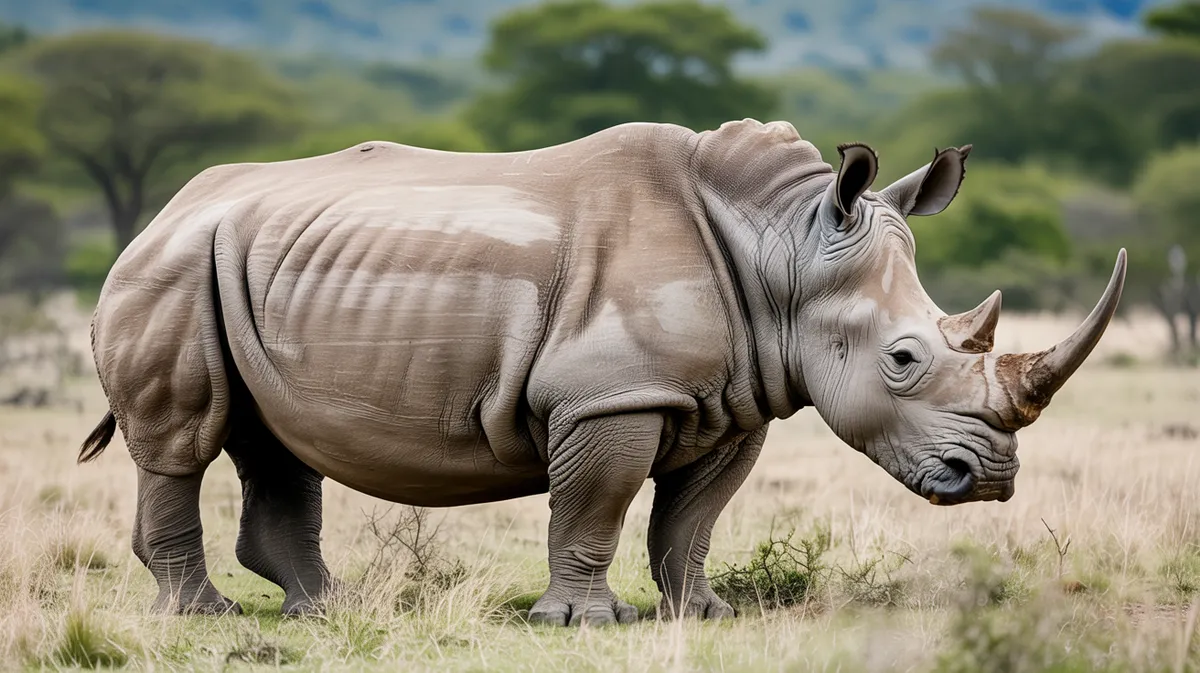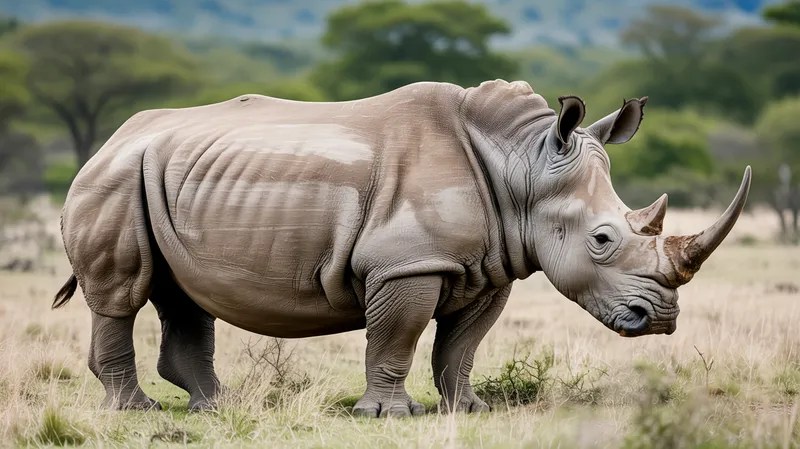
White Rhinoceros
Ceratotherium simum

Meet the White Rhinoceros
The White Rhinoceros is the largest species of rhinoceros and the second-largest land mammal after the elephant. Characterized by its broad, square-shaped mouth adapted for grazing, it has two distinct subspecies: the Southern white rhinoceros and the critically endangered Northern white rhinoceros. White rhinos have thick, grayish skin and two prominent horns on their snout, with the front horn being larger. They are social animals, often found in small groups, and rely heavily on open grasslands for survival. Despite their massive size and strength, they face severe threats from poaching for their horns and habitat loss.
Classification
Mammal
Habitat
Savanna and grassland
Diet
Herbivore
Lifespan
40-50 years
Conservation
Near Threatened
Weight
1,400–3,500 kg (3,100–7,700 lbs)
📖Fascinating Facts
Largest Rhino Species
The White Rhinoceros is the largest of all rhinoceros species and can weigh as much as a small car.
Wide Mouth Adaptation
Its broad, flat mouth is uniquely adapted for grazing on grasses across African savannas.
Superb Sense of Smell
White rhinos have highly developed olfactory senses, allowing them to detect other animals and humans from a great distance.
📋Detailed Description
The white rhinoceros (Ceratotherium simum) is a massive, barrel-bodied ungulate, with adults typically measuring 3.4–4.2 meters in length and standing 1.5–1.85 meters at the shoulder. Adult males can weigh between 2,000 and 2,400 kg, while females are slightly lighter, averaging 1,600–2,000 kg. Their skin is thick (up to 2 cm), grayish, and sparsely covered with hair, providing protection from thorns and insect bites. The species is distinguished by its broad, square-shaped mouth, an adaptation for grazing on short grasses, and two prominent keratinous horns—the front horn often reaching 60–150 cm in length. White rhinos possess a large head, muscular neck, and a pronounced hump over the shoulders formed by powerful muscles supporting the head. They have poor eyesight but an acute sense of smell and hearing, with large, mobile ears. Socially, white rhinos are the most gregarious of all rhinoceros species, forming groups (crashes) of up to 14 individuals, typically composed of females and their offspring. Males are territorial and mark their ranges with dung piles and urine sprays. Their home ranges can overlap, but dominant bulls defend prime territories, especially those with access to water and wallowing sites. White rhinos are diurnal, being most active during the cooler hours of the day, and spend much of their time grazing, wallowing in mud, or resting in shade.
💡 Did you know?
The Northern white rhinoceros subspecies is functionally extinct, with only two known individuals remaining, both of which are females.
🔬Research & Sources
Wikipedia Summary
The white rhinoceros, also known as the white rhino or square-lipped rhinoceros, is the largest extant species of rhinoceros and the most social of all rhino species, characterized by its wide mouth adapted for grazing. The species includes two subspecies with dramatically different conservation outlooks: the southern white rhinoceros, with an estimated 17,464 individuals in the wild as of the end of 2023, and the northern white rhinoceros. The northern subspecies is critically endangered and on the brink of extinction; its last known male, Sudan, died in March 2018, leaving behind only a very small number of females in captivity. Both subspecies have faced significant threats, primarily from poaching for their horns and habitat loss, which contribute to the species' overall conservation status of Near Threatened.
Last Modified: 5/25/2025
🎭Behavior & Social Structure
White rhinoceroses are predominantly grazers, feeding almost exclusively on short grasses, which they crop with their wide, square lips. They spend up to half of their day grazing and require regular access to water, drinking daily if possible. Socially, females and subadults form loose groups, while adult males are generally solitary and territorial. Territorial males mark boundaries with dung middens and urine, and may engage in ritualized displays or physical confrontations to defend their territory. Communication includes vocalizations such as snorts, grunts, and bellows, as well as olfactory cues left at dung piles. Wallowing in mud is a common behavior, serving both to regulate body temperature and to protect against parasites. White rhinos are crepuscular, with peak activity at dawn and dusk, and rest during the hottest part of the day. They have a relatively slow walking gait but can charge at speeds up to 40 km/h when threatened.
👶Reproduction & Life Cycle
White rhinoceroses are polygynous, with dominant territorial males mating with multiple females whose home ranges overlap their territory. Courtship involves prolonged following and ritualized displays, sometimes lasting several days. Mating can be aggressive, with copulation lasting up to an hour. The gestation period is approximately 16 months, one of the longest among land mammals. Females typically give birth to a single calf (rarely twins), weighing 40–65 kg at birth. Calves are precocial, able to stand and walk within hours, and remain with their mothers for up to 2–3 years, until the next calf is born. Interbirth intervals are typically 2.5–3 years. There is no fixed breeding season, but births may peak during the rainy season in some regions. Males do not participate in parental care.
🛡️Adaptations & Survival
The white rhinoceros exhibits several key adaptations for its grazing lifestyle. Its wide, square-shaped mouth is specialized for cropping large quantities of short grasses, and its large head and muscular neck support this feeding strategy. The thick, tough skin protects against thorns, insect bites, and sun exposure. Large, mobile ears and a highly developed sense of smell compensate for poor eyesight, aiding in detecting predators and conspecifics. The prominent horns, composed of keratin, are used for defense, dominance displays, and digging for water or breaking branches. Wallowing in mud helps regulate body temperature and protects against ectoparasites. Social behaviors, such as group living and communal dung middens, facilitate communication and reduce predation risk for calves.
📚Research Sources
🎨Cultural Significance
White rhinoceroses have significant cultural and symbolic value in African societies, often representing strength, resilience, and the wild heritage of the continent. In some local traditions, rhino horns were believed to have medicinal or magical properties, though scientific evidence does not support these claims. The species has become a flagship for conservation campaigns, symbolizing the broader struggle against wildlife poaching and habitat loss. In modern times, white rhinos are a major attraction in ecotourism, contributing to local economies and raising awareness about conservation needs. Their plight has inspired international collaborations and public engagement through media, art, and advocacy.
🔬Recent Research & Discoveries
Recent research on white rhinoceroses has focused on genetics, reproductive biology, and conservation management. Notably, advanced reproductive technologies are being developed to attempt the rescue of the northern white rhinoceros, including the creation of embryos using stored genetic material and surrogate mothers from the southern subspecies. Studies on social behavior have revealed complex communication networks, including vocal and chemical signaling. Long-term monitoring of populations using GPS collars and drones has improved understanding of movement patterns, habitat use, and responses to environmental changes. Research into the microbiome of white rhinos is shedding light on digestive adaptations to a high-fiber, grass-based diet. Conservation genetics is being used to manage inbreeding and maintain genetic diversity in both wild and captive populations.
🎥Wildlife Videos

These Two Rhinos Are The Last Of Their Kind | Seven Worlds, One Planet | BBC Earth
There are only two northern white rhinos left on the planet; the result of decades of poaching of the species. Can science save the ...
BBC Earth

Uganda's southern white rhinos | DW English
There were none left in Uganda until the Rhino Fund imported a few and started a breeding program. Now there are 24 at its ...
DW News

This Is The ONLY Northern White Rhino Left On Earth | Extraordinary Animals | Our World
Subscribe to Our World: https://bit.ly/3xnPuGL Sudan is the only male white rhino left on Earth. This incredible story is about to ...
Our World

Meet the Heroes Who Protect the Last Northern White Rhinos in the World | Short Film Showcase
In Kenya, a brave group of rangers are working to protect the last three northern white rhinoceros in the world. ➡ Subscribe: ...
National Geographic

Saving Kenya's Last Two Northern White Rhinos
In the vast expanse of the Ol Pejeta Conservancy in Kenya, desperate efforts are ongoing for the survival of the only two northern ...
TRT Afrika

The Northern White Rhino A Species on the Brink of Extinction
In this eye-opening documentary, we explore the poignant story of the last Northern White Rhino on Earth. With only two ...
GeneralDocumentary
🌍Habitat Information
The White Rhinoceros typically inhabits Savanna and grassland environments. White Rhinoceross have adapted to their environments with specialized features and behaviors.
Primary Habitat:
Savanna and grassland
More detailed habitat information will be available soon.
🛡️Conservation Status
The White Rhinoceros is currently classified as Near Threatened. Conservation efforts are crucial for preserving this species for future generations.
Common Threats:
- 🏠Habitat loss and fragmentation
- 🌡️Climate change impacts
- 🎯Hunting and poaching
- 🏭Human-wildlife conflict
⚠️Threats & Conservation Challenges
The primary threat to white rhinoceroses is poaching for their horns, driven by demand in traditional medicine and as status symbols, particularly in parts of Asia. Habitat loss and fragmentation due to agriculture, human settlement, and infrastructure development further reduce available range and resources. The northern white rhinoceros (C. s. cottoni) is functionally extinct in the wild, with only two known females remaining in captivity as of 2024, making natural recovery impossible. The southern white rhinoceros (C. s. simum) has rebounded from near extinction in the early 20th century but remains vulnerable to poaching surges and political instability. Disease outbreaks, droughts, and inbreeding in small populations also pose risks. Conservation efforts include anti-poaching patrols, translocations, habitat management, and, for the northern subspecies, advanced reproductive technologies such as in vitro fertilization.
🔬Scientific Classification
Scientific Name
Ceratotherium simum
Classification Hierarchy
🔍 About Taxonomic Classification
Taxonomic classification is a hierarchical system used by scientists to classify and organize living organisms based on shared characteristics and evolutionary relationships.
The system moves from broad categories (Kingdom) to increasingly specific ones, with each animal's scientific name typically consisting of its Genus and species.
📝Community Notes
Share your observations and insights about the White Rhinoceros with our community of wildlife enthusiasts.
Join Our Community
Sign in to share your observations and connect with fellow wildlife enthusiasts.
Sign In to ContributeNo community notes yet
Be the first to share your observations about the White Rhinoceros!
Explore White Rhinoceros
Select a tab above to learn more about this amazing animal.
📸Photo Gallery
No photos available for this animal yet.
🌟Discover More Wildlife
Continue your journey of discovery with more fascinating animals from our database
